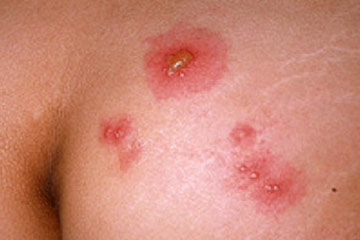Lymphocytic Choriomeningitis Virus from Pet Rodents
Rodents, such as mice, hamsters and guinea pigs, are popular as pets in many households. However, not all rodents that enter homes are intended as pets: some rodents are brought into homes as feed for other animals (e.g., pet snakes), and others, such as the house mouse, are pests that find their own way into homes. This fact sheet is intended to provide information about lymphocytic choriomeningitis virus (LCMV), which can be transmitted to humans by rodents, including wild and pet mice, hamsters, and, on occasion, guinea pigs.
What is LCMV?
LCMV is carried by rodents and can be passed to humans. Not all people who are exposed to the virus become ill. Signs and symptoms of LCMV infection are similar to those for influenza and include fever, stiff neck, malaise, anorexia (lack of appetite), muscle aches, headache, nausea, and vomiting. Symptoms occur 1–2 weeks after exposure.
How is LCMV transmitted to humans?
The house mouse, a wild rodent found near and in homes, is the primary host of this virus. Humans can develop LCMV infection from exposure to rodent urine, droppings, saliva, or nesting material of infected rodents. Virus transmission can also occur when these materials are directly introduced into broken skin or into the nose, eyes, or mouth or by a bite from an infected animal. Pet rodents, such as hamsters and guinea pigs, can become infected with LCMV after being in contact with wild rodents at a breeding facility, pet store, or home. Human infections from pet rodents are rare.
Can other pets transmit LCMV to humans?
While it might be possible for other animals to become infected with the virus, documented infections in humans have occurred only after exposure to infected mice and hamsters. Human infections almost always occur from house mice and rarely occur from pet hamsters.
How long are hamsters infected with LCMV?
The length of time that hamsters are infected with LCMV varies. It has been documented that chronically infected hamsters can transmit virus for at least eight months. This is long enough for infected animals to reproduce and transmit the infection to their offspring.
Do hamsters show signs of LCMV infection?
The effect of LCMV infection on hamsters is highly variable. Some hamsters may not show signs of infection. Those that do show signs of infection have been infected and transmitting virus for several months. The early signs of LCMV infection in a hamster include loss of activity, loss of appetite, and rough coat. Later, the animal may show signs of weight loss, hunched posture, inflammation of the eye lids, and eventually death. This can take several weeks or months.
Can hamsters be tested for LCMV?
We do not recommend testing any pet hamsters. Tests on live hamsters may be inaccurate.
How can the risk of getting LCMV be reduced?
LCMV infection can be prevented by avoiding contact with house mice and by taking precautions when handling pet rodents (i.e., mice, hamsters, or guinea pigs).
If you have a pet rodent, take the following precautions to reduce the risk of LCMV infection:
- Wash hands with soap and water after handling pet rodents; use waterless alcohol-based hand rubs when soap is not available. Keep rodent cages clean and free of soiled bedding. Clean the cage in a well-ventilated area or outside. Wash hands thoroughly with soap and water after cleaning up pet droppings. Closely supervise young children, especially those less than five years old, when cleaning cages, and make sure they wash their hands immediately after handling rodents and rodent caging or bedding.
- Do not kiss pet rodents or hold them close to your face.
If you have a rodent infestation in and around your home, take the following precautions to reduce the risk of LCMV infection:
- Seal up rodent entry holes or gaps with steel wool, lath metal, or caulk. Trap rats and mice by using an appropriate snap trap. Clean up rodent food sources and nesting sites and take precautions when cleaning rodent-infected areas. See recommendations the LCMV Web site for more information about cleaning rodent-infested areas.
- Keep wild rodents away from pet rodents.
Are hamsters or other rodents safe pets for children? Are they safe pets for the classroom?
Hamsters and other pet rodents are common and very popular pets. Additionally, the number of documented LCMV infections from pets has been rare.
Should pregnant women be concerned about owning a hamster or other rodent?
Although the risk of LCMV infection from pet rodents is generally low. However, pregnant women should be aware of the risks associated with acquiring LCMV infection during pregnancy. Some of the following precautions can be taken to reduce even further the risk of acquiring LCMV infection during pregnancy:
- Pregnant women should avoid contact with wild rodents. If you have a household rodent infestation, it should be addressed promptly by a professional pest control company or another member of the household.
- Keep your pet rodent in a separate part of the home and ask another family member or friend to clean the cage and care for the pet. Avoid prolonged stays in the room where the rodent resides.
What should be considered when purchasing a hamster or other pet rodent?
It may be difficult to identify a pet rodent with LCMV infection since the effect of the infection on pet rodents is highly variable. However, here are some general steps that can be taken to prevent pet rodents from bringing other diseases into your home.
It is always advisable to obtain your pet from a source that has an active health monitoring program. When choosing a pet rodent, don’t pick one that is quiet, tired, has diarrhea, or looks sickly. The pet should be lively and alert, with a glossy coat free of droppings. The animal’s breathing should be normal. There should be no discharge from the eyes or nose.
If one of the animals in the cage in a pet store has diarrhea or looks sick, the others may have been exposed to an infectious disease. Do not choose any of these animals as your pet. Wash your hands immediately after handling pet store animals or after touching animal cages or bedding.
If your pet dies soon after you buy it, it could have been ill with a disease that could also make people sick. Use gloves when removing the dead rodent from the cage. Then double-bag the animal and throw out the bag in an appropriate waste disposal system. Tell the pet store and do not reuse the cage until it has been cleaned and disinfected.
Source
Centers for Disease Control and Prevention
More Information:
-
Importation of Pets and Other Animals Into the United States
-
Pet Travel
-
Pets Travel Container
-
Diseases from Dogs
-
Diseases from Cats
-
Choosing a Pocket Pet
-
Lymphocytic Choriomeningitis Virus from Pet Rodents
-
Pregnant Woman and Toxoplasmosis
-
You Can Prevent Toxoplasmosis (Toxo)
-
HIV. Preventing Infections from Pets
-
You can Prevent Cryptosporidiosis






